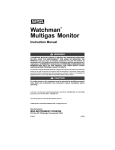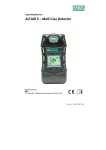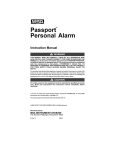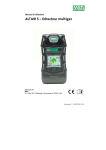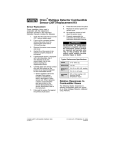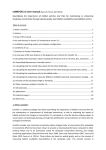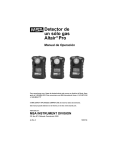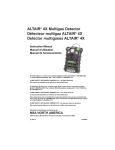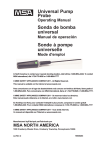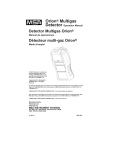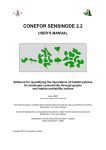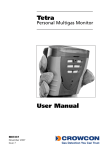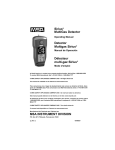Download Solaris® MultiGas Detector
Transcript
Solaris® MultiGas Detector Operating Manual In North America, to contact your nearest stocking location, dial toll-free 1-800-MSA-2222 To contact MSA International, dial 1-412-967-3354 or 1-800-MSA-7777 © MINE SAFETY APPLIANCES COMPANY 2005 - All Rights Reserved This manual is available on the internet at www.msanet.com Manufactured by MSA INSTRUMENT DIVISION P.O. Box 427, Pittsburgh, Pennsylvania 15230 (L) Rev 2 10046201 " WARNING THIS MANUAL MUST BE CAREFULLY READ BY ALL INDIVIDUALS WHO HAVE OR WILL HAVE THE RESPONSIBILITY FOR USING OR SERVICING THE PRODUCT. Like any piece of complex equipment, this instrument will perform as designed only if it is used and serviced in accordance with the manufacturer’s instructions. OTHERWISE, IT COULD FAIL TO PERFORM AS DESIGNED AND PERSONS WHO RELY ON THIS PRODUCT FOR THEIR SAFETY COULD SUSTAIN SEVERE PERSONAL INJURY OR DEATH. The warranties made by Mine Safety Appliances Company with respect to the product are voided if the product is not used and serviced in accordance with the instructions in this manual. Please protect yourself and others by following them. We encourage our customers to write or call regarding this equipment prior to use or for any additional information relative to use or service. i Table of Contents Chapter 1, Instrument Safety and Certifications . . . . . .1-1 " WARNING . . . . . . . . . . . . . . . . . . . . . . . . . . . . .1-1 Safety Limitations and Precautions . . . . . . . . . . . . . . . .1-2 Date of Instrument Manufacture . . . . . . . . . . . . . . . . . . .1-4 Certifications . . . . . . . . . . . . . . . . . . . . . . . . . . . . . . . . . .1-4 Electronic Interference . . . . . . . . . . . . . . . . . . . . . . . . . .1-4 Chapter 2, Using the Solaris Multigas Detector . . . . . . .2-1 Turning ON the Solaris Multigas Detector . . . . . . . . . . .2-1 Last Cal Date . . . . . . . . . . . . . . . . . . . . . . . . . . . . . . . . .2-1 Cal Due Date . . . . . . . . . . . . . . . . . . . . . . . . . . . . . . . . .2-2 Instrument Alarm Bypass Options . . . . . . . . . . . . . . . . .2-2 Fresh Air Set Up Option . . . . . . . . . . . . . . . . . . . . . . . . .2-3 " WARNING . . . . . . . . . . . . . . . . . . . . . . . . . . . . .2-3 Figure 2-1. Battery Indicator . . . . . . . . . . . . . . . . . .2-3 Battery Life Indicator (FIGURE 2-1) . . . . . . . . . . . . . .2-4 Battery Warning . . . . . . . . . . . . . . . . . . . . . . . . . . . . .2-4 Battery Shutdown . . . . . . . . . . . . . . . . . . . . . . . . . . . .2-4 " WARNING . . . . . . . . . . . . . . . . . . . . . . . . . . . . .2-4 Sensor Missing Alarm . . . . . . . . . . . . . . . . . . . . . . . . .2-5 " CAUTION . . . . . . . . . . . . . . . . . . . . . . . . . . . . . .2-5 " WARNING . . . . . . . . . . . . . . . . . . . . . . . . . . . . .2-5 " WARNING . . . . . . . . . . . . . . . . . . . . . . . . . . . . .2-5 Calibration Check . . . . . . . . . . . . . . . . . . . . . . . . . . . . . .2-6 Measuring Gas Concentrations . . . . . . . . . . . . . . . . . . .2-6 Combustible gases (% LEL) (FIGURE 2-2) . . . . . . . . .2-6 Figure 2-2. Instrument in LEL Alarm . . . . . . . . . . . .2-6 " WARNING . . . . . . . . . . . . . . . . . . . . . . . . . . . . .2-7 Oxygen Measurements (% O2) (FIGURE 2-3) . . . . . .2-8 Figure 2-3. Instrument in Oxygen Alarm . . . . . . . . .2-8 " WARNING . . . . . . . . . . . . . . . . . . . . . . . . . . . . .2-8 Toxic Gas Measurements (FIGURE 2-4) . . . . . . . . . . .2-9 ii Solaris Multigas Detector Equipped with an NO2 Sensor Only . . . . . . . . . . . . . . . . . . . . . . . . . . . . .2-9 Figure 2-4. Instrument in Toxic Gas Alarm . . . . . . .2-9 " WARNING . . . . . . . . . . . . . . . . . . . . . . . . . . . . .2-9 " CAUTION . . . . . . . . . . . . . . . . . . . . . . . . . . . . .2-10 Figure 2-5. Instrument in NO2 Gas Alarm (NO2 Versions Only) . . . . . . . . . . . . . . . . . .2-10 Safe LED . . . . . . . . . . . . . . . . . . . . . . . . . . . . . . . . . .2-11 Operating Beep . . . . . . . . . . . . . . . . . . . . . . . . . . . . .2-11 Viewing Optional Displays (FIGURE 2-6) . . . . . . . . . .2-12 Figure 2-6. Flow Diagram . . . . . . . . . . . . . . . . . . .2-12 Peak Readings (PEAK) (FIGURE 2-7) . . . . . . . . . . .2-13 Minimum Readings (MIN) (FIGURE 2-8) . . . . . . . . . .2-13 Figure 2-7. PEAK Readings on the Display . . . . .2-13 Figure 2-8. MIN Reading on the Display . . . . . . . .2-13 Short Term Exposure Limits (STEL) (FIGURE 2-9) . .2-14 To Reset the STEL: . . . . . . . . . . . . . . . . . . . . . . . . . .2-14 Figure 2-9. Exposure Page with STEL Alarm . . . .2-14 Time Weighted Average (TWA) (FIGURE 2-10) . . . .2-15 " WARNING . . . . . . . . . . . . . . . . . . . . . . . . . . . .2-15 Figure 2-10. Exposure Page with TWA Alarm . . . .2-15 To Reset the TWA: . . . . . . . . . . . . . . . . . . . . . . . . . . .2-16 " WARNING . . . . . . . . . . . . . . . . . . . . . . . . . . . .2-16 Time Display (FIGURE 2-11) . . . . . . . . . . . . . . . . . . .2-17 Date Display (FIGURE 2-12) . . . . . . . . . . . . . . . . . . .2-17 Turning OFF the Solaris Multigas Detector . . . . . . . . .2-17 Figure 2-11 Time Display . . . . . . . . . . . . . . . . . . . .2-17 Figure 2-12. Date Display . . . . . . . . . . . . . . . . . . .2-17 " CAUTION . . . . . . . . . . . . . . . . . . . . . . . . . . . . . .3-1 Chapter 3, Setting up the Solaris Multigas Detector . . .3-1 Power Systems . . . . . . . . . . . . . . . . . . . . . . . . . . . . . . .3-1 Table 3-1. Battery Capacity Reductions Expected at Colder Temperatures . . . . . . . . .3-1 Battery Charging (Lithium Ion Battery version only) . .3-1 To Charge the Instrument . . . . . . . . . . . . . . . . . . . . . .3-1 Battery Replacement (Alkaline Battery Version Only) .3-2 Changing Instrument Settings . . . . . . . . . . . . . . . . . . . .3-2 iii " WARNING . . . . . . . . . . . . . . . . . . . . . . . . . . . . .3-2 Figure 3-1. Battery Replacement . . . . . . . . . . . . . . .3-2 Accessing the Instrument Setup Mode . . . . . . . . . . . . .3-3 Chapter 4, Calibration . . . . . . . . . . . . . . . . . . . . . . . . . . . .4-1 " WARNING . . . . . . . . . . . . . . . . . . . . . . . . . . . . .4-1 Calibrating the Solaris Multigas Detector . . . . . . . . . . . .4-1 Table 4-1. Autocalibration and Required Calibration Cylinders . . . . . . . . . . . . . . . . . . .4-1 To Calibrate the Solaris Multigas Detector (FIGURE 4-1): . . . . . . . . . . . . . . . . . . . . . . . . . . . . . . .4-2 Figure 4-1. Calibration Flow Chart . . . . . . . . . . . . . .4-3 Figure 4-2. Zero Flag . . . . . . . . . . . . . . . . . . . . . . . .4-4 Figure 4-3. CAL Flag . . . . . . . . . . . . . . . . . . . . . . . .4-4 Autocalibration Failure . . . . . . . . . . . . . . . . . . . . . . . . .4-5 Chapter 5, Warranty and Live Maintenance Procedures 5-1 MSA Portable Instrument Warranty . . . . . . . . . . . . . . . .5-1 Cleaning and Periodic Checks . . . . . . . . . . . . . . . . . . . .5-2 " WARNING . . . . . . . . . . . . . . . . . . . . . . . . . . . . . .5-2 " WARNING . . . . . . . . . . . . . . . . . . . . . . . . . . . . . .5-2 Storage . . . . . . . . . . . . . . . . . . . . . . . . . . . . . . . . . . . . . .5-3 Shipment . . . . . . . . . . . . . . . . . . . . . . . . . . . . . . . . . . . .5-3 Troubleshooting . . . . . . . . . . . . . . . . . . . . . . . . . . . . . . .5-3 " WARNING . . . . . . . . . . . . . . . . . . . . . . . . . . . . . .5-3 Live Maintenance Procedures . . . . . . . . . . . . . . . . . . . .5-4 Sensor Replacement . . . . . . . . . . . . . . . . . . . . . . . . . .5-4 " WARNING . . . . . . . . . . . . . . . . . . . . . . . . . . . . . .5-4 " WARNING . . . . . . . . . . . . . . . . . . . . . . . . . . . . . .5-5 Chapter 6, Performance Specifications . . . . . . . . . . . . . .6-1 Table 6-1. Certifications (see instrument label to determine applicable approval) . . . . . . . . . . .6-1 Table 6-2. Instrument Specifications . . . . . . . . . . .6-1 iv Table 6-3. COMBUSTIBLE GAS - Typical Performance Specifications . . . . . . . . . . . . . .6-2 Table 6-4. COMBUSTIBLE GAS - Cross Reference Factors for Solaris General-Purpose Calibration Using Calibration Cylinder (P/N 10045035) Set to 58% LEL Pentane Simulant . . . . . . . . .6-2 Table 6-5. Combustible Gas - Cross Reference Factors for Solaris FX . . . . . . . . . . . . . . . . . .6-4 Table 6-6. OXYGEN - Typical Performance Specifications . . . . . . . . . . . . . . . . . . . . . . . . .6-5 6-7. CARBON MONOXIDE (appropriate models only) - Typical Performance Specifications . . . . . . . . . . . . . . . . . . . . . . . . .6-6 Table 6-8. CARBON MONOXIDE - Cross Reference Factors for Solaris Calibration Using Calibration Cylinder (P/N 10045035) . .6-6 Table 6-9. HYDROGEN SULFIDE (appropriate models only) - Typical Performance Specifications . . . . . . . . . . . . . . . . . . . . . . . . .6-7 Table 6-10. HYDROGEN SULFIDE - Cross Reference Factors for Solaris Calibration Using Calibration Cylinder (P/N10045035) . .6-7 Table 6-11. Nitrogen (Appropriate Models Only) Dioxide Typical Performance Specifications .6-8 Table 6-12. Nitrogen Dioxide (Appropriate Models Only) Cross Reference Factors for Solaris Calibration . . . . . . . . . . . . . . . . . . . . .6-8 Chapter 7, Replacement and Accessory Parts . . . . . . . .7-1 Table 7-1. Replacement Parts List . . . . . . . . . . . . .7-2 Table 7-2. Accessory Parts List . . . . . . . . . . . . . . .7-3 Table 7-3. Accessory Parts List (NO2 Versions Only) . . . . . . . . . . . . . . . . . . .7-3 Figure 7-1. Replacement Parts (see Table 7-1) . . . .7-4 v Chapter 1, Instrument Safety and Certifications The Solaris Multigas Detector is for use by trained and qualified personnel. It is designed to be used when performing a hazard assessment to: • Assess potential worker exposure to combustible and toxic gases and vapors • Determine the appropriate gas and vapor monitoring needed for a workplace. The Solaris Multigas Detector can be equipped to detect: • • • Combustible gases and certain combustible vapors Oxygen-deficient or oxygen-rich atmospheres Specific toxic gases for which a sensor is installed. " WARNING • Read and follow all instructions carefully. • Check calibration before each day's use and adjust if necessary. • Check calibration more frequently if exposed to silicone, silicates, lead-containing compounds, hydrogen sulfide, or high contaminant levels. • Recheck calibration if unit is subjected to physical shock. • Use only to detect gases/vapors for which a sensor is installed. • Do not use to detect combustible dusts or mists. • Make sure adequate oxygen is present. • Do not block sensors. • Have a trained and qualified person interpret instrument readings. • Do not recharge Li ION battery in a combustible atmosphere. • Do not replace alkaline batteries in a combustible atmosphere. • Do not alter or modify instrument. INCORRECT USE CAN CAUSE SERIOUS PERSONAL INJURY OR DEATH. 1-1 Safety Limitations and Precautions Carefully review the following safety limitations and precautions before placing this instrument in service: • • The Solaris Multigas Detector is designed to: • Detect gases and vapors in air only • Detect only specified toxic gases for which a sensor is installed. Perform the following check before each day's use to verify proper instrument operation: • • Calibration check (see Calibration Check section). Adjust calibration if the readings are not within the specified limits. Check calibration more frequently if the unit is subjected to physical shock or high levels of contaminants. Also, check calibration more frequently if the tested atmosphere contains the following materials, which may desensitize the combustible gas sensor and reduce its readings: • Organic silicones • Silicates • Lead-containing compounds • Hydrogen sulfide exposures over 200 ppm or exposures over 50 ppm for one minute. • The minimum concentration of a combustible gas in air that can ignite is defined as the Lower Explosive Limit (LEL). A combustible gas reading of "100" or “5.00” indicates the atmosphere is above 100% LEL or 5.00% CH4, respectively, and an explosion hazard exists. In such cases, the instrument LockAlarm feature activates. Move away from contaminated area immediately. • Do not use the Solaris Multigas Detector to test for combustible or toxic gases in the following atmospheres as this may result in erroneous readings: 1-2 • Oxygen-deficient or oxygen-rich atmospheres • Reducing atmospheres • Furnace stacks • Inert environments • Atmospheres containing combustible airborne mists/dusts. • Do not use the Solaris Multigas Detector to test for combustible gases in atmospheres containing vapors from liquids with a high flash point (above 38°C, 100°F) as this may result in erroneously low readings. • Do not block sensor openings as this may cause inaccurate readings. Do not press on the face of the sensors, as this may damage them and cause erroneous readings. Do not use compressed air to clean the sensor holes, as the pressure may damage the sensors. • Allow sufficient time for unit to display accurate reading. Response times vary based on the type of sensor being utilized (see Chapter 6, "Performance Specifications"). • All instrument readings and information must be interpreted by someone trained and qualified in interpreting instrument readings in relation to the specific environment, industrial practice and exposure limitations. • Do not recharge lithium ion battery or replace alkaline batteries in a hazardous area. Use only battery chargers made available by MSA for use with this instrument; other chargers may damage the battery pack and the unit. Dispose of batteries in accordance with local health and safety regulations. • Do not alter this instrument; otherwise, damage may result. • Use of the GalaxyTM Automated Test System is an alternate MSHAapproved method for calibrating MSHA-approved Solaris instruments. • Use only calibration gas that is 2.5% Methane with an accuracy of +5% when calibrating MSHA-approved Solaris instruments. • The maximum acceptable user-settable (password protected) Galaxy Automated Test System tolerance on Bump Limits must only be set to 10% or less when calibrating MSHA-approved Solaris instruments. • For 30 CFR Part 75 determinations, the maximum acceptable usersettable (password protected) Galaxy Automated Test System tolerance on Bump Limits must only be set to such that 19.5% oxygen can be detected with an accuracy of +0.5% when calibrating MSHA-approved Solaris instruments. 1-3 Date of Instrument Manufacture The date of manufacture of your Solaris Multigas Detector is coded into the instrument serial number. • The last three digits represent the month (the letter) and the year (the two-digit number). • The letter corresponds to the month starting with A for January, B for February, etc. Certifications Tests completed by MSA verify that the Solaris Multigas Detector meets applicable industry and government standards as of the date of manufacture. Refer to Chapter 6, TABLE 6-1, for specific certifications. Electronic Interference • This instrument generates, uses, and can radiate radio frequency energy. Operation of this instrument may cause interference, in which case, the user may be required to correct. • This device is test equipment and is not subject to FCC technical regulations. However, it has been tested and found to comply with the limits for a Class A digital device specified in Part 15 of the FCC regulations. • This digital apparatus does not exceed the Class A limits for radio noise emissions from digital apparatus set out in the Radio Interference Regulations of the CRTC. • There is no guarantee that interference will not occur. If this instrument is determined to cause interference to radio or television reception, try the following corrective measures: 1-4 • Reorient or relocate the receiving antenna • Increase separation between the instrument and the radio/TV receiver • Consult an experienced radio/TV technician for help. Chapter 2, Using the Solaris Multigas Detector Turning ON the Solaris Multigas Detector Press the Power ON button; the instrument displays: 1. A self-test: • All segments display • Audible alarm sounds • Alarm light illuminate • Vibrator activates • Software version displays • Internal diagnostics • "VISUAL OFF" displays if red LEDs disabled • "BACKLITE OFF" displays if backlight disabled • "AUDIBLE OFF" displays if buzzer disabled • "VIBRATE OFF" displays if vibrator disabled. 2. Alarm setpoints: • Low • High • STEL (if activated) • TWA (if activated) 3. Calibration gas (expected calibration gas values) 4. Time and date (if data logging option installed) 5. Last CAL date (if data logging option installed) 6. CAL due date (if activated and if data logging option installed) 7. Instrument warm-up period 8. Fresh Air Setup option. Last Cal Date The Solaris Multigas Detector is equipped with a “last successful calibration date” feature. The date shown is the last date that all installed sensors were successfully calibrated. "LAST CAL" is displayed with this date in the following format: • MM:DD:YY If any of the sensors were not previously calibrated, "LAST CAL, INVALID" is displayed. 2-1 Cal Due Date The Solaris Multigas Detector (with data logging and software version 1.1 or higher) is equipped with a Calibration Due Date feature. To activate this feature, see Chapter 3, “Accessing the Instrument Setup Mode”. If the calibration due date feature is activated, following Last Cal Date, the message "CAL DUE, X DAYS" appears on the instrument LCD. • x = the number of days until a calibration is due, user selectable for 1 to 180 days. If the number of days until calibration is due reaches 0, an alert occurs and "CAL DUE, --NOW--" displays. • Press the RESET button to clear the alert and continue with the instrument warm-up period. During Normal Measure mode, if the calibration due date feature is activated and calibration is due, the instrument beeps and displays "CAL DUE" every 30 seconds until the unit is calibrated. Perform a calibration check before each day’s use to verify proper instrument operation (see Chapter 2, “Calibration Check”). Instrument Alarm Bypass Options The Solaris Multigas Detector (with software version 1.1 or higher) is equipped with a feature to disable or silence the visual, backlight, audible, and vibrator options. To activate this feature, see Chapter 3, “Accessing the Instrument Setup Mode”. If any of these options (visual, backlight, audible, or vibrator) are disabled during instrument startup, the Solaris Detector displays: • "VISUAL OFF" if the red LEDs are disabled • "BACKLITE OFF" if backlight is disabled • "AUDIBLE OFF" if audible buzzer is disabled • "VIBRATE OFF" if the vibrator is disabled. If the visual, audible, or vibrator options are disabled, "ALARM OFF" flashes on the LCD during Normal Measure mode. 2-2 Fresh Air Set Up Option (for automatic zero adjustment of the Solaris Multigas Detector sensors) NOTE: The Fresh Air Setup (FAS) has limits. If a hazardous level of gas is present, the Solaris Multigas Detector ignores the FAS command and goes into alarm. " WARNING Do not activate the Fresh Air Setup unless you are certain you are in fresh, uncontaminated air; otherwise, inaccurate readings can occur which can falsely indicate that a hazardous atmosphere is safe. If you have any doubts as to the quality of the surrounding air, do not use the Fresh Air Setup feature. Do not use the Fresh Air Setup as a substitute for daily calibration checks. The calibration check is required to verify span accuracy. Failure to follow this warning can result in serious personal injury or death. Persons responsible for the use of the Solaris Multigas Detector must determine whether or not the Fresh Air Setup option should be used. The user's abilities, training and normal work practices must be considered when making this decision. 1. Turn ON the Solaris Multigas Detector. • Once the instrument self check is complete, ZERO? flashes for 10 seconds. 2. To perform a Fresh Air Setup, push the ON/OFF button while ZERO? is flashing. 3. To immediately skip the FAS, push the RESET button. • If no buttons are pushed, the ZERO? automatically stops flashing after the 10 seconds have expired and the FAS is not performed. Figure 2-1. Battery Indicator 2-3 Battery Life Indicator (FIGURE 2-1) • The battery condition icon continuously displays in the upper portion of the screen, regardless of the selected page. • As the battery charge dissipates, segments of the battery icon go blank until only the outline of the battery icon remains. Battery Warning • A Battery Warning indicates that a nominal 15 minutes of operation remain before instrument batteries are completely depleted. NOTE: Duration of remaining instrument operation during Battery Warning depends on ambient temperatures. • When the Solaris Multigas Detector goes into Battery Warning: • Battery Life indicator flashes • “BATT WRN” flashes every 15 seconds • Alarm sounds • Lights flash every 15 seconds • The Solaris Multigas Detector continues to operate until the instrument is turned OFF or battery shutdown occurs. Battery Shutdown When the batteries can no longer operate the instrument, the instrument goes into Battery Shutdown mode: • LOW and BATTERY flash on the display • Alarm sounds and lights flash • Alarm can be silenced by pressing the RESET button • No other pages can be viewed • After approximately one minute, the instrument automatically turns OFF. " WARNING When Battery Shutdown condition sounds, stop using the instrument; it can no longer alert you of potential hazards since it does not have enough power to operate properly: 1. Leave the area immediately. 2. Turn OFF the instrument if it is ON. 3. Report to the person responsible for maintenance 4. Recharge the battery or replace the batteries. 2-4 Failure to follow this procedure, could result in serious personal injury or death. " CAUTION During "Battery Low" condition, prepare to exit the work area since the instrument could go into "Battery Shutdown" at any time, resulting in loss of sensor function. Depending on the age of the batteries, ambient temperature and other conditions, the instrument "Battery Low" and "Battery Shutdown" times could be shorter than anticipated. " WARNING Recharge the instrument or replace the batteries when the "Battery Low" or "Battery Shutdown" conditions occur. Sensor Missing Alarm The Solaris Multigas Detector will enter the Sensor Missing alarm if the instrument detects that an enabled sensor is not properly installed in the instrument. For O2, CO, and H2S sensors, the Sensor Missing feature is checked when the instrument is turned ON and when leaving the Setup mode. The combustible Sensor Missing feature is continually monitored. If a sensor is detected as missing, the following occurs: • SENSOR and MISSING flash on the display • The flag above the sensor detected as missing flashes on the display • Alarm sounds and lights flash • Alarm can be silenced by pressing the RESET button • No other pages can be viewed • After approximately one minute, the instrument automatically turns OFF. " WARNING If a Sensor Missing condition occurs, stop using the instrument; it can no longer alert you of potential hazards. 1. Leave the area immediately. 2. Turn OFF the instrument if it is ON. 3. Report to the person responsible for maintenance Failure to follow this procedure could result in serious personal injury or death. 2-5 Calibration Check The calibration check is simple and should only take about one minute. Perform this calibration check before each day's use. 1. Turn ON the Solaris Multigas Detector in clean, fresh air. 2. Verify that readings indicate no gas is present. 3. Attach calibration cap to the Solaris Multigas Detector. 4. Ensure that "TOP" and "↑" on the calibration cap are oriented so that “TOP” is positioned at the top of the instrument. 5. Attach regulator (supplied with calibration kit) to the cylinder. 6. Connect tubing (supplied with calibration kit) to the regulator. 7. Attach other end of tubing to the calibration cap. 8. Open the valve on the regulator. • The regulator flow rate is 0.25 lpm. • The reading on the Solaris Multigas Detector display should be within the limits stated on the calibration cylinder or limits determined by your company. • If necessary, change cylinder to introduce other calibration gases. • If readings are not within these limits, the Solaris Multigas Detector requires recalibration. See Chapter 4, "Calibration." Measuring Gas Concentrations Combustible Gases (% LEL) (FIGURE 2-2) Figure 2-2. Instrument in LEL Alarm 2-6 The Solaris Multigas Detector can be equipped to detect combustible gases in the atmosphere. • Alarms sound when concentrations reach: • Alarm Setpoint or • • 100% LEL (Lower Explosive Limit), 5% CH4. When the combustible gas indication reaches the Alarm Setpoint: • Alarm sounds • Alarm lights flash • • % LEL or CH4 flag above the concentration flashes. To silence the alarm, press the RESET button. NOTE: The alarm will stay silent if the alarm condition has cleared. • When the combustible gas indication reaches 100% LEL or 5% CH4, the LockAlarm circuit locks the combustible gas reading and alarm and: TM • • Alarm sounds • Alarm lights flash • 100 or 5.00 appears on the display and flashes. This alarm cannot be reset with the RESET button. " WARNING If the 100% LEL or 5.00% CH4 alarm condition is reached, you may be in a life-threatening situation; there is enough gas in the atmosphere for an explosion to occur. In addition, any rapid up-scale reading followed by a declining or erratic reading can also be an indication that there is enough gas for an explosion. If either of these indications occur, leave and move away from the contaminated area immediately. Failure to follow this warning can result in serious personal injury or death. • After moving to a safe, fresh-air environment, reset the alarm by turning OFF the instrument and turning it ON again. 2-7 Oxygen Measurements (% O2) (FIGURE 2-3) Figure 2-3. Instrument in Oxygen Alarm The Solaris Multigas Detector can be equipped to detect the amount of oxygen in the atmosphere. • • Two conditions trigger the alarm: • Too little oxygen (deficient) • Too much oxygen (enriched). When the alarm setpoint is reached for either of the above: • Alarm sounds • Alarm lights flash • % O2 flag above the concentration flashes. " WARNING If the Oxygen alarm condition is reached while using the instrument as a personal or area monitor, leave the area immediately; the ambient condition has reached a preset alarm level. If using the instrument as an inspection device, do not enter the area without proper protection. Failure to follow this warning will cause exposure to a hazardous environment which can result in serious personal injury or death. 2-8 Toxic Gas Measurements (FIGURE 2-4) Figure 2-4. Instrument in Toxic Gas Alarm • The Solaris Multigas Detector can be equipped to detect: • Carbon Monoxide (CO) and/or • Hydrogen Sulfide (H2S) in the atmosphere. • When the alarm setpoint is reached for Carbon Monoxide (CO) and/or Hydrogen Sulfide (H2S): • Alarm Sounds • Alarm Lights flash • PPM CO or PPM H2S flag above the concentration flashes. " WARNING If the Toxic Gas alarm condition is reached while using the instrument as a personal or area monitor, leave the area immediately; the ambient condition has reached a preset alarm level. If using the instrument as an inspection device, do not enter the area without proper protection. Failure to follow this warning will cause over-exposure to toxic gases, which can result in serious personal injury or death. Solaris Multigas Detector Equipped with an NO2 Sensor Only • The Solaris Multigas Detector can be equipped to detect NO2. Units are identified: • at turn-ON by displaying 'TOX2 NO2' • during continuous operation, by scrolling 'Solaris NO2' across the display. 2-9 The following operations remain the same for the H2S, CO, and NO2 sensors: • sensor missing alarm • sensor setup • calibration • TWA • STEL. " CAUTION NO2, H2S or any toxic sensor cannot be interchanged to a different location within the instrument; otherwise, improper operation will result. The NO2 Sensor: • must be placed in the black sensor holder • gasket is also black. Figure 2-5. Instrument in NO2 Gas Alarm (NO2 Versions Only) 2-10 Safe LED The Solaris Multigas Detector is equipped with a green "SAFE LED". This green SAFE LED will flash every 15 seconds under the following conditions: • The green SAFE LED is enabled • Instrument is on the normal Measure Gases page • • Combustible reading is 0% LEL or 0%CH4 Oxygen (O2) reading is 20.8% • Carbon Monoxide (CO) reading is 0 ppm • • Hydrogen Sulfide (H2S) reading is 0 ppm No gas alarms are present (low or high) • Instrument is not in Low Battery warning or alarm • CO, H2S, STEL and TWA readings are 0 ppm. Operating Beep The Solaris Multigas Detector is equipped with an operating beep. This operating beep activates every 30 seconds by momentarily beeping the horn and flashing the alarm LEDs under the following conditions: • Operating beep is enabled • Instrument is on normal Measure Gases page • Instrument is not in Battery warning • Instrument is not in Gas alarm • Audible and visual options enabled. 2-11 Viewing Optional Displays (FIGURE 2-6) The diagram shown in FIGURE 2-6 describes the flow for optional displays. Figure 2-6. Flow Diagram Press the PAGE button to move to: 2-12 Peak Readings (PEAK) (FIGURE 2-7) Figure 2-7. PEAK Readings on the Display • • PEAK appears in the upper portion of the display to show the highest levels of gas recorded by the Solaris Multigas Detector since: • Turn-ON or • Peak readings were reset. To Reset the Peak Readings: 1. Access the Peak page. 2. Press the RESET button. Minimum Readings (MIN) (FIGURE 2-8) Figure 2-8. MIN Reading on the Display • This page shows the lowest level of oxygen recorded by the Solaris Multigas Detector since: 2-13 • Turn-ON or • MIN reading was reset. • MIN appears in the upper portion of the display. • To reset the MIN Reading: 1. Access the Min page. 2. Press the RESET button. Short Term Exposure Limits (STEL) (FIGURE 2-9) Figure 2-9. Exposure Page with STEL Alarm • The STEL flag appear in the upper portion of the display to show the average exposure over a 15-minute period. • When the amount of gas detected by the Solaris Multigas Detector is greater than the STEL limit: • Alarm sounds • Alarm lights flash • STEL flashes. To Reset the STEL: 1. Access the STEL page. 2. Press the RESET button. The STEL alarm is calculated over a 15-minute exposure. Calculation examples are as follows: • Assume the Detector has been running for at least 15 minutes: 2-14 • 15-minute exposure of 35 PPM: (15 minutes x 35 PPM) = 35 PPM 15 minutes • 10-minute exposure of 35 PPM 5-minute exposure of 15 PPM: (10 minutes x 35 PPM) + (5 minutes x 5 PPM) = 25 PPM 15 minutes " WARNING If the STEL alarm condition is reached while using the instrument as a personal or area monitor, leave the contaminated area immediately; the ambient gas concentration has reached the preset STEL alarm level. Failure to follow this warning will cause over-exposure to toxic gases, which can result in serious personal injury or death. Time Weighted Average (TWA) (FIGURE 2-10) Figure 2-10. Exposure Page with TWA Alarm • The TWA flag will appear in the upper portion of the display to show the average exposure since the instrument was turned ON or the TWA reading was reset. • When the amount of gas detected by the Solaris Multigas Detector is greater than the eight-hour TWA limit: • Alarm Sounds 2-15 • Alarm Lights Flash • TWA flashes. To Reset the TWA: 1. Access the TWA page. 2. Press the RESET button. The TWA alarm is calculated over an eight-hour exposure. Calculation examples are as follows: • 1-hour exposure of 50 PPM: (1 hour x 50 PPM) + (7 hours x 0 PPM) = 6.25 PPM 8 hours • 4-hour exposure of 50 PPM 4-hour exposure of 100 PPM: (4 hours x 50 PPM) + (4 hours x100 PPM) = 75 PPM 8 hours • 12-hour exposure of 100 PPM: (12 hours x 100 PPM) = 150 PPM 8 hours NOTE: The accumulated reading is always divided by eight hours. " WARNING If the TWA alarm condition is reached while using the instrument as a personal or area monitor, leave the contaminated area immediately; the ambient gas concentration has reached the preset TWA alarm level. Failure to follow this warning will cause over-exposure to toxic gases, which can result in serious personal injury or death. Time Display (FIGURE 2-11) 2-16 Figure 2-11 Time Display • TIME appears on the display to show the current time of day in a 24-hour format. Date Display (FIGURE 2-12) Figure 2-12. Date Display • DATE appears on the display with the current date displayed in the following format: • MM:DD:YY Turning OFF the Solaris Multigas Detector Push and Hold the ON-OFF button for three seconds. NOTE: Releasing the ON-OFF button before the three seconds elapse returns the instrument to the Measure page. 2-17 Chapter 3, Setting up the Solaris Multigas Detector Power Systems The Solaris instrument is supplied with a Li ION battery or three AA Alkaline batteries. These batteries have a nominal runtime of 14 and 12 hours, respectively. In colder temperatures, battery output may be reduced. See TABLE 3-1 for capacity reductions expected for batteries at these temperatures. Table 3-1. Battery Capacity Reductions Expected at Colder Temperatures TEMPERATURE Li ION AA ALKALINE 21°C (70°F) None None -20°C (-4°F) 40% 90% Battery Charging (Lithium Ion Battery version only) Charge the battery by using the Charger supplied with the instrument. " CAUTION Use of any charger, other than the Charger supplied with the instrument, may damage or improperly charge the batteries. • The charger is capable of charging a completely depleted pack in less than four hours in normal, room-temperature environments. NOTE: Allow very hot or cold instruments to stabilize for one hour at room temperature before attempting to charge. • Minimum and maximum ambient temperature to charge the instrument is 10°C, 50°F and 35°C, 95°F, respectively. • For best results, charge the instrument at room temperature (23°C) To Charge the Instrument • Carefully place instrument into the charge stand. • Charger status is indicated by the LED. • Green: Charging complete • Red: Charging in process • Yellow: Failure Mode; remove from charger. 3-1 • "CHARGE" flashes on the Solaris display when the unit is installed on the charge stand • This is not an indication that the charge is complete Battery Replacement (Alkaline Battery Version Only) " WARNING Do not remove the intrument’s batteries in a hazardous area To replace Solaris Multigas Detector batteries: 1. Unscrew the captive screws from the bottom and top of the battery door. 2. Replace the batteries, using only batteries listed on the Approval Label. 3. Attach battery door to instrument and tighten the screws. Figure 3-1. Battery Replacement Changing Instrument Settings • • Many options can be set using the instrument buttons. If the Solaris Multigas Detector was ordered with the optional datalogging, the MSA FiveStar LINK software can be used to set most of the instrument selections, including some that cannot be changed from the instrument's front panel buttons. 3-2 Accessing the Instrument Setup Mode 1. Press and hold the RESET button while turning the instrument ON. • SETUP displays. NOTE: In all of the following selections in this Set-up mode: • Press ON/OFF to enter chosen value/go to the next page. • Press the ON/OFF button to store the chosen value. • Press RESET to decrement by one or toggle ON/OFF. • Press and hold RESET to decrement by 10. • Press PAGE to increment by one or toggle ON/OFF. • Press and hold PAGE to increment by 10. 2. Enter password default "672". 3. Press ON/OFF to enter password. • Correct Password: instrument continues/beeps three times. • Incorrect Password: instrument enters the Measure mode. 4. Password ON/OFF (turns the password protection ON or OFF) 5. New Password Setup (changes the password) 6. Instrument Options Setup • Safe LED ON/OFF • Instrument Alarm Bypass Options Setup • • Visual alarm ON/OFF (red LEDs) • Audible alarm ON/OFF (buzzer) • Vibrator ON/OFF Backlight ON/OFF • Backlight timer (10 seconds to 10 minutes) • OP beep ON/OFF • STEL/TWA ON/OFF • Time (if data logging option installed) • Date (if data logging option installed) • CAL Due ON/OFF (if data logging option installed) • CAL Due duration (1 to 180 days) 3-3 7. LEL/CH4 Setup • Sensor ON/OFF (turns the sensor ON or OFF) • Display Combustible Gas Type? • Methane • Pentane • Hydrogen • Propane • LEL or Ch4 mode (displays % LEL (for any gas) or % CH4 (for Methane only) • Low Alarm (sets the low combustible alarm) • High Alarm (sets the high combustible alarm) • Cal Gas (sets the expected combustible calibration gas) 8. O2 Setup • Sensor ON/OFF (turns the sensor ON or OFF) • Low Alarm • High Alarm 9. CO Setup • Sensor ON/OFF (turns the sensor ON or OFF) • Low Alarm (sets the low CO alarm) • High Alarm (sets the high CO alarm) • STEL Alarm (if enabled) (sets the STEL CO alarm) • TWA Alarm (if enabled) (sets the TWA CO alarm) • Cal Gas (sets the expected CO calibration gas) 10.TOX2 Setup (H2S or NO2) • Sensor ON/OFF (sets TOX2 sensor ON or OFF) • Low Alarm (sets the low TOX2 alarm) • High Alarm (sets the high TOX2 alarm) • STEL Alarm (if enabled) (sets the STEL TOX2 alarm) • TWA Alarm (if enabled) (sets the TWA TOX2 alarm) • Cal Gas (sets the expected TOX2 calibration gas) 3-4 Chapter 4, Calibration Calibrating the Solaris Multigas Detector Each Solaris Multigas Detector is equipped with an Autocalibration feature to make unit calibration as easy as possible. The Autocalibration sequence resets instrument zeroes and adjusts sensor calibration for known concentrations of calibration gases. Table 4-1. Autocalibration and Required Calibration Cylinders SENSORS EXPECTED GAS* CONCENTRATION FOUR-GAS CYLINDER (P/N 10045035) FOUR-GAS CYLINDER (P/N 10058171) FOUR-GAS CYLINDER (P/N 10058034) Combustible 58% LEL Combustible 2.5% CH4 Oxygen 15% Carbon Monoxide 60 ppm Hydrogen Sulfide 20 ppm Nitrogen Dioxide 10 ppm *Factory Default LEL Mode Methane Mode LEL Mode NOTES: • Refer to Chapter 3, "Setting up the Multigas Detector", for instructions on changing the autocalibration expected gas concentrations if calibration gas with concentrations other than those listed above will be used to calibrate the instrument. • For 30 C.F.R. Part 75 determinations (MSHA versions), the Solaris Multigas Detector must be operated in the 0-5% by volume CH4 mode and must be calibrated with 2.5% by volume methane. " WARNING The expected gas concentrations must match the gas concentrations listed on the calibration cylinder(s). Failure to follow this warning will cause an incorrect calibration, which can result in serious personal injury or death. 4-1 To Calibrate the Solaris Multigas Detector (FIGURE 4-1): 1. Turn ON the instrument and verify that battery is sufficiently charged. 2. Wait until the Measure Gases page appears. 3. Push and hold the RESET button until CAL ZERO? flashes on the display (FIGURE 4-2). 4. Push the ON-OFF button to zero the instrument. • Instrument must be in fresh air to perform the zero. • CAL ZERO flashes. NOTE: To skip the Zero procedure and move directly to the calibration span procedure, push the RESET button. If no button is pushed for 30 seconds, the instrument returns to the Measure mode. • 4-2 Once the zeros are set, CAL SPAN? flashes (FIGURE 4-3). Figure 4-1. Calibration Flow Chart 4-3 Figure 4-2. Zero Flag Figure 4-3. CAL Flag 4. Connect the appropriate calibration gas to the instrument. 5. Attach the calibration cap to the instrument. a. Connect one end of the tubing to the calibration cap. b. Connect other end of tubing to the cylinder regulator (supplied in the calibration kit). c. Ensure that "TOP" and "↑" on the calibration cap are oriented so that "TOP" is positioned at the top of the instrument. 6. Open the valve on the regulator. 7. Push the ON-OFF button to calibrate (span) the instrument. • CAL SPAN flashes for approximately 90 seconds. • If autocalibration sequence passes, the instrument beeps three times and returns to the Measure mode. NOTE: 4-4 To skip calibration and return to the Measure mode, push the RESET button.If no button is pushed for 30 seconds, the instrument returns to the Measure mode. 8. Remove the calibration cap. 9. Close the valve on the regulator. NOTE: The autocalibration procedure adjusts the span value for any sensor that passes the test; sensors that fail autocalibration are left unchanged. Since residual gas may be present, the instrument may briefly go into an exposure alarm after the calibration sequence is completed. Autocalibration Failure If the Solaris Multigas Detector cannot calibrate one or more sensor(s), the instrument goes into the Autocalibration Failure Page and remains in alarm until the RESET button is pushed. Sensors that could not be calibrated are indicated by dashed lines on the concentration display. 4-5 Chapter 5, Warranty and Live Maintenance Procedures MSA Portable Instrument Warranty 1. WarrantyITEM WARRANTY PERIOD Chassis and electronics Two years All sensors, unless otherwise specified Two years This warranty does not cover filters, fuses, etc. Certain other accessories not specifically listed here may have different warranty periods. This warranty is valid only if the product is maintained and used in accordance with Seller's instructions and/or recommendations. The Seller shall be released from all obligations under this warranty in the event repairs or modifications are made by persons other than its own or authorized service personnel or if the warranty claim results from physical abuse or misuse of the product. No agent, employee or representative of the Seller has any authority to bind the Seller to any affirmation, representation or warranty concerning this product. Seller makes no warranty concerning components or accessories not manufactured by the Seller, but will pass on to the Purchaser all warranties of manufacturers of such components. THIS WARRANTY IS IN LIEU OF ALL OTHER WARRANTIES, EXPRESSED, IMPLIED OR STATUTORY, AND IS STRICTLY LIMITED TO THE TERMS HEREOF. SELLER SPECIFICALLY DISCLAIMS ANY WARRANTY OF MERCHANTABILITY OR OF FITNESS FOR A PARTICULAR PURPOSE. 2. Exclusive Remedy- It is expressly agreed that Purchaser's sole and exclusive remedy for breach of the above warranty, for any tortious conduct of Seller, or for any other cause of action, shall be the replacement at Seller's option, of any equipment or parts thereof, which after examination by Seller is proven to be defective. Replacement equipment and/or parts will be provided at no cost to Purchaser, F.O.B. Seller's Plant. Failure of Seller to successfully replace any nonconforming equipment or parts shall not cause the remedy established hereby to fail of its essential purpose. 5-1 3. Exclusion of Consequential Damages- Purchaser specifically understands and agrees that under no circumstances will seller be liable to purchaser for economic, special, incidental or consequential damages or losses of any kind whatsoever, including but not limited to, loss of anticipated profits and any other loss caused by reason of nonoperation of the goods. This exclusion is applicable to claims for breach of warranty, tortious conduct or any other cause of action against seller. Cleaning and Periodic Checks As with all electronic equipment, the Solaris Multigas Detector will operate only if it is properly maintained. " WARNING Alteration of the Solaris Multigas Detector, beyond the procedures described in this manual or by anyone other than a person authorized by MSA, could cause the instrument to fail to perform properly. Use only genuine MSA replacement parts when performing any maintenance procedures described in this manual. Substitution of components can seriously impair instrument performance, alter intrinsic safety characteristics or void agency approvals. FAILURE TO FOLLOW THIS WARNING CAN RESULT IN SERIOUS PERSONAL INJURY OR DEATH. " WARNING Do not attempt to clean the sensor cover while it is in place; sensor damage may occur. The tops of sensors are very fragile; do not touch or apply pressure to the tops of any sensors. If a sensor is damaged, it can cause the unit to give false readings. 5-2 Storage When not in use, store your Solaris Multigas Detector in a safe, dry place between -5° and 40°C (23° and 104°F). " WARNING After storage, always recheck instrument calibration before use. During storage, sensors may drift or become inoperative and may not provide warnings of dangers to the health and lives of users. Shipment Pack the Solaris Multigas Detector in its original shipping container with suitable padding. If the original container is unavailable, an equivalent container may be substituted. Seal instrument in a plastic bag to protect it from moisture. Use sufficient padding to protect it from the rigors of handling. Damage due to improper packaging or damage in shipment is not covered by the instrument's warranty. Troubleshooting The Solaris Multigas Detector will operate reliably for years when cared for and maintained properly. If the instrument becomes inoperative, you may contact MSA at: . • MSA Instrument Division Service Department 1000 Cranberry Woods Drive Cranberry Township, PA 16066-5207 1-800-MSA-INST To contact MSA International, please call: • 1-412-967-3000 or 1-800-MSA-7777 5-3 Live Maintenance Procedures Sensor Replacement 1. Verify that the instrument is turned OFF. 2. Remove the front case. 3. Gently lift out and properly discard the sensor to be replaced. • • Remove the CO or H2S sensor with a nonconductive or nonmetallic flat blade screwdriver or similar tool by pressing against the sensor holder tab and lifting out the sensor: • CO sensor holder tab is in upper left corner • H2S sensor holder tab is in upper right corner. Remove the combustible or oxygen sensor gently with your fingers only. " WARNING Remove and reinstall sensors carefully, ensuring that the components are not damaged. Damage can adversely affect the intrinsic safety of the instrument and result in serious personal injury or death. 4. Verify that combustible and oxygen sensor standoffs are installed. NOTE: Sensor positions cannot be changed: • The CO sensor must be placed in the red sensor holder. • • Note that the CO gasket in the sensor is also red. The H2S sensor must be placed in the blue sensor holder. • Note that the H2S gasket in the sensor is also blue. 5. Carefully align the new sensor contact pins with the sockets on the printed circuit board. 6. Press the new sensor into place. 5-4 • Press the CO sensor into place by placing the sensor under the sensor holder tab first; then, press into place (CO sensor tab is located in the upper left-hand corner of the sensor Holder). • Press the H2S sensor into place by placing the sensor under the sensor holder tab first; then, press into place (H2S sensor tab is located in the upper right-hand corner of the sensor Holder). • If a CO or an H2S sensor is not to be installed, ensure that a “dummy” cell is installed properly in place. 7. Replace the sensor gasket and sensor filters in the front case. 8. Re-install the screws. " WARNING Verification of calibration response is required; otherwise, the instrument will not perform as required, and persons relying on this product for their safety could sustain serious personal injury or death. 5-5 Chapter 6, Performance Specifications Table 6-1. Certifications (see instrument label to determine applicable approval) HAZARDOUS LOCATIONS PERFORMANCE APPLICABLE EUROPEAN DIRECTIVES US (NON-MINING) UL913 for Class I, Div. 1, Groups A, B, C and D, Tamb=-20°C to +50°C US (MINING) 30 CFR Part 22, Methane Detector CANADA CSA C22.2, No. 157 for Class I, Div. 1, Groups A, B, C and D, Tamb=-20°C to +50°C EUROPE EEx ia dIIC, Tamb=-20°C to +50°C AUSTRALIA Ex ia S Zone 0 I/IIC US (MINING) 30 CFR Part 22, Methane Detector CANADA CSA C22.2, No. 152 for Methane EUROPE IEC60529 EUROPE EN50054, EN50057 (for Methane) EUROPE EN50271 (Software and Digital Technologies) ATEX 94/9/EC II 2G EEx ia d IIC, T3 (157°C), Tamb=-20°C to +50°C EMC 89/336/EEC EN50270 (EN50081-1, EN50082-2) Table 6-2. Instrument Specifications TEMPERATURE RANGE NORMAL 0 to 40°C EXTENDED* -20 TO 0°C, 40 to 50°C SHORT PERIODS -40 TO-20°C (15 minutes) INGRESS PROTECTION RATING (IP) MEASUREMENT METHOD IP65 COMBUSTIBLE GAS Catalytic Sensor OXYGEN Electrochemical Sensor TOXIC GASES Electrochemical Sensors 6-1 FACTORY-SET ALARM SETPOINTS CO H2S LEL O2 NO2 *NOTE: LOW ALARM 35 PPM 10 PPM 10% 19.5% 2.5 PPM HIGH ALARM 100 PPM 15 PPM 20% 23.0% 5.0 PPM STEL 400 15 --5.0 TWA 35 10 --2.5 Extended temperature range indicates gas readings may vary slightly if calibrated at room temperature. For optimal performance, calibrate instrument at temperature of use. Table 6-3. COMBUSTIBLE GAS - Typical Performance Specifications RANGE 0 to 10 0% LEL or 0 to 5.00% CH4 RESOLUTION 1% LEL or 0.05% CH4 REPRODUCIBILITY 3% LEL, 0% to 50% LEL reading or .15% CH4, 0.00% to 2.50% CH4 (normal temperature range*) 5% LEL, 50% to 100% LEL reading or .25% CH4, 2.50% to 5.00% CH4 (normal temperature range*) 5% LEL, 0% to 50% LEL reading or .25% CH4, 0.00% to 2.50% CH4 (extended temperature range*) RESPONSE TIME 8% LEL, 50% to 100% LEL reading or . 0.40% CH4, 2.50% to 5.00% CH4 (extended temperature range*) 90% of final reading in 30 seconds (normal temperature range*) (LEL only) 90% of final reading in 20 seconds (Methane) *See TABLE 6-2 NOTE Table 6-4. COMBUSTIBLE GAS - Cross Reference Factors for Solaris General-Purpose Calibration Using Calibration Cylinder (P/N 10045035) Set to 58% LEL Pentane Simulant COMBUSTIBLE GAS 6-2 MULTIPLY %LEL READING BY Acetone 1.1 Acetylene 0.7 Acrylonitrile1 0.8 Benzene 1.1 Butane 1.0 1,3 Butadiene 0.9 COMBUSTIBLE GAS MULTIPLY % LEL READING BY n-Butanol 1.8 Carbon Disulfide1 2.2 Cyclohexane 1.1 2,2 Dimethylbutane 1.2 2,3 Dimethylpentane 1.2 Ethane 0.7 Ethyl Acetate 1.2 Ethyl Alcohol 0.8 Ethylene 0.7 Formaldehyde2 0.5 Gasoline 1.3 Heptane 1.4 Hydrogen 0.6 n-Hexane 1.3 Isobutane 0.9 Isobutyl Acetate 1.5 Isopropyl Alcohol 1.1 Methane 0.6 Methanol 0.6 Methyl Isobutyl ketone 1.1 Methylcyclohexane 1.1 Methyl Ethyl Ketone 1.1 Methyl Tertiary Butyl Ether 1.0 Mineral Spirits 1.1 iso-Octane 1.1 n-Pentane 1.0 Propane 0.8 Propylene Styrene2 0.8 Tetrahydrofuran 0.9 Toluene 1.2 Vinyl Acetate 0.9 VM&P Naptha 1.6 O-Xylene 1.2 1.9 6-3 RESPONSE NOTES: 1. The compounds may reduce the sensitivity of the combustible gas sensor by poisoning or inhibiting the catalytic action. 2. These compounds may reduce the sensitivity of the combustible gas sensor by polymerizing on the catalytic surface. 3. For an instrument calibrated on Pentane,multiply the displayed %LEL value by the conversion factor above to get the true %LEL. 4. These conversion factors should be used only if the combustible gas is known. 5. These conversion factors are typical for a Solaris Multigas Detector. Individual units may vary by + 25% from these values Table 6-5. COMBUSTIBLE GAS - Cross Reference Factors for Solaris FX This TABLE shows the variation in response of the 4P-50 CiTipel® on exposure to a range of gases and vapors at the same % LEL concentration GAS VAPOR RELATIVE SENSITIVITY* GAS VAPOR RELATIVE SENSITIVITY* Methane 100 Carbon monoxide Propane 65 Acetone 115 70 nButane 65 Methyl ethyl ketone 55 n-Pentane 60 Toluene 40 n-Hexane 50 Ethyl acetate 60 n-Heptane 45 Hydrogen 115 n-Octane 40 Ammonia** 130 Methanol 95 Cyclohexane 55 Ethanol 85 Leaded petrol 60 Iso-propyl alcohol 60 Unleaded petrol 60 Acetylene 80 Ethylene 85 *Each sensitivity has been rounded to the nearest 5%. **T90 for Ammonia is extended. Contact City Technology for details. RESPONSE NOTES: 1. The compounds may reduce the sensitivity of the combustible gas sensor by poisoning or inhibiting the catalytic action. 2. These compounds may reduce the sensitivity of the combustible gas sensor by polymerizing on the catalytic surface. 3. The figures are experimentally derived and expressed relative to the methane signal (= 100). 4. These conversion factors should be used only if the combustible gas is known. 5. The results are intended for guidance only. For the most accurate measurements, an instrument should be calibrated using the gas under investigation. 6-4 Table 6-6. OXYGEN - Typical Performance Specifications RANGE RESOLUTION 0 to 25% O2 0.1% O2 REPRODUCIBILITY 0.7% O2, for 0 to 25% O2 0.7% O2 for O2 < = 15% (MSHA version only) 0.5% O2, for O2: <O2 < =25% (MSHA version only) RESPONSE TIME 90% of final reading 30 seconds (normal temperature range*) 3 minutes (extended temperature range) *See TABLE 6-2 NOTE Environment and Oxygen Sensor Readings A number of environmental factors may affect the oxygen sensor readings, including changes in pressure, humidity and temperature. Pressure and humidity changes affect the amount of oxygen actually present in the atmosphere. Pressure Changes If pressure changes rapidly (e.g., stepping through airlock) the oxygen sensor reading may temporarily shift, and possibly cause the detector to go into alarm. While the percentage of oxygen may remain at or near 20.8%, the total amount of oxygen present in the atmosphere available for respiration may become a hazard if the overall pressure is reduced to a significant degree. Humidity Changes If humidity changes to any significant degree (e.g., going from a dry, air conditioned environment to outdoor, moisture laden air), oxygen levels can change up to 0.5%. This is due to water vapor in the air displacing oxygen, thus reducing oxygen readings as humidity increases. The oxygen sensor has a special filter to reduce the affects of humidity changes on oxygen readings. This effect will not be noticed immediately, but slowly impacts oxygen readings over several hours. Temperature Changes The oxygen sensor has built-in temperature compensation. However, if temperature shifts dramatically, the oxygen sensor reading may shift. Zero the instrument at a temperature within 30°C of the temperature-ofuse for the least effect. 6-5 Table 6-7. CARBON MONOXIDE (appropriate models only) Typical Performance Specifications RANGE 500 ppm CO RESOLUTION 1 ppm CO, for 5 to 500 ppm CO REPRODUCIBILITY +5 ppm CO or 10% of reading, whichever is greater 0 to 300 ppm CO, +15% >300 ppm CO (normal temperature range*) +10 ppm CO or 20% of reading, whichever is greater (extended temperature range*) RESPONSE TIME 90% of final reading in 60 seconds (normal temperature range*) *See TABLE 6-2 NOTE Table 6-8. CARBON MONOXIDE - Cross Reference Factors for Solaris Calibration Using Calibration Cylinder (P/N 10045035) NOTE: Data is presented as the indicated output in ppm, which would result from the application of 100 ppm of the test gas. TEST GAS (100 PPM) 100 +9 Hydrogen Sulfide (H2S) 4 +4 TEST GAS (100 PPM) EQUIVALENT PPM Sulfur Dioxide (SO2) Nitrogen Dioxide (NO2) 0 +1 Nitric Oxide (NO) 70 +10 Chlorine (Cl2) 1 +8 Ammonia (NH3) Hydrogen Chloride (HCl) 2 +4 Ethylene (C2H4) Hydrogen Cyanide (HCN) 6-6 EQUIVALENT PPM Carbon Monoxide (CO) 2 +6 3 +2 90 +9 0 +1 Methane (CH4) Ethanol (EtOH) 0 +0 Hydrogen (H2) 70 +26 4 +5 Table 6-9. HYDROGEN SULFIDE (appropriate models only) - Typical Performance Specifications RANGE RESOLUTION REPRODUCIBILITY 200 ppm H2S 1 ppm H2S, for 3 to 200 ppm H2S +2 ppm H2S or 10% of reading, whichever is greater 0 to 100 ppm H2S, +15% > 100 ppm H2S (normal temperature range*) +5 ppm H2S or 20% of reading, whichever is greater (extended temperature range*) RESPONSE TIME 90% of final reading in 60 seconds* (normal temperature range) *See TABLE 6-2 NOTE Table 6-10. HYDROGEN SULFIDE - Cross Reference Factors for Solaris Calibration Using Calibration Cylinder (P/N10045035) NOTE: Data is presented as the indicated output in ppm, which would result from the application of 100 ppm of the test gas TEST GAS (100 PPM) Hydrogen Sulfide (H2S) Ethylene (C2H4) Methane (CH4) Hydrogen (H2) TEST GAS (100 PPM) EQUIVALENT PPM 100 +10 0 +0 0 +0 0 +0 EQUIVALENT PPM Ammonia (NH3) 0 +0 Chlorine (Cl2) Nitrogen Dioxide (NO2) 0 +0 Nitric Oxide (NO) 1 +1 -20 +2 Carbon Monoxide (CO) 4 +4 Hydrogen Chloride (HCl) 0 +0 Hydrogen Cyanide (HCN) 1 +1 Sulfur Dioxide (SO2) Ethanol (EtOH) 10 +3 Toluene 0 +0 0 +0 6-7 Table 6-11. Nitrogen (Appropriate Models Only) Dioxide Typical Performance Specifications RANGE 50.0 ppm RESOLUTION 0.1 ppm H2S, for 0.5 to 50.0 ppm NO2 +0.5 ppm NO2 or 10% of reading, whichever is greater (normal temperature range*) REPRODUCIBILITY +0.5 ppm NO2 or 20% of reading, whichever is greater (extended temperature range*) RESPONSE TIME 90% of final reading in 60 seconds (normal temperature range*) *See TABLE 6-2 NOTE. Table 6-12. Nitrogen Dioxide (Appropriate Models Only) Cross Reference Factors for Solaris Calibration NOTE: Data is presented as the indicated output in ppm, which would result from the application of 10 ppm of the test gas TEST GAS (10 PPM) EQUIVALENT PPM Hydrogen Sulfide (H2S) Sulfur Dioxide (SO2) -12.7 +1.2 Carbon Monoxide (CO) 0 +0 Nitric Oxide (NO) 0 +0 Ammonia (NH3) Methane (CH4) 0 +0 6-8 -.6 +.1 0 +0 Chapter 7, Replacement and Accessory Parts 7-1 Table 7-1. Replacement Parts List ITEM NO. PART PART NO. 1 Gasket, Sensor Gasket, Sensor (FX only) 10044926 10055500 2 CO Button Cell Sensor 10046944 3 4 H2S Button Cell Sensor O2 Sensor 10046945 10046946 5 Combustible Sensor Combustible Sensor (FX only) 10046947 10055612 6 Case, Assembly, Front Case, Assembly, Front (Alkaline only) Case, Assembly, Front (FX only) 10044996 10068951 10055515 7 Sensor, Plug, Inactive, Button Cell (quantity: up to 2) 10046292 8 Insert, Support, Combustible Sensor 10046762 9 10 Insert, Support, O2 Sensor Filter, Charcoal, CO 10047967 11 Charger, Cradle, Assembly (Rechargeable only) 10048185 12 Felt, Protection (quantity: 4) 10044927 13 Cap, Calibration Assembly 10044994 14 Fitting, Male Tapper Luer (quantity: 2) 637266 15 North American Power Supply (Rechargeable only) 10047342 16 17 Global Power Supply Rear Case Assembly Rear Case Assembly Rear Case Assembly Rear Case Assembly 10047343 10044997 10068952 10053219 10057044 18 20 Main PC Board Assembly, Non-I.R.D.A. Main PC Board Assembly, Non-I.R.D.A. (Alkaline only) Main PC Board Assembly, Non-I.R.D.A.(Australia only) Main PC Board, NO2, Non-I.R.D.A. Main PC Board Assembly, I.R.D.A. Main PC Board Assembly, I.R.D.A.(Alkaline only) Main PC Board Assembly, I.R.D.A.(Australia only) Main PC Board, NO2, I.R.D.A. Label, Sensor Cover (quantity: 2) 10045008 10065937 10056978 10059028 10045009 10065936 10056979 10059027 10049052 21 Case Screws (quantity: 5) 655289 22 Main PC Board Assembly Screws (quantity: 2) 10046937 Main PC Board Assembly Screws (quantity: 2) (Alkaline only) 10040570 23 24 25 26 Horn Chamber Protective Insert NO2 Button Cell Sensor Filter, Nafion, NO2 only Ring, Adhesive, NO2 only 19 7-2 (Rechargeable only) (includes battery) (Alkaline only) (Euro) (Euro) (Australia only) 10046763 10046042 10059040 711505 10011287 Table 7-2. Accessory Parts List PART PART NO. Universal Pump Probe, North America 10046528 Universal Pump Probe, MSHA Universal Pump Probe, Europe Calibration Assembly Regulator, .25 LPM, Model RP Regulator, Combination, .25 LPM, Model RP Datalog Kit (Software/Eye) Infrared Datalogging Software Cordura Jacket (rechargeable only) Cordura Jacket (Alkaline only) Four Gas Econocal (1.45% CH4, 15.0% O2, 60 ppm CO, 20 ppm Three Gas Econocal (1.45% CH4, 15.0% O2, 20 ppm H2S) Four Gas Econocal (2.50% CH4, 15.0% O2, 60 ppm CO, 20 ppm Three Gas Econocal (2.50% CH4, 15.0% O2, 20 ppm H2S) Three Gas Econocal (1.45% CH4, 15.0% O2, 60 ppm CO) Three Gas RP (1.45% CH4, 15.0% O2, 20 ppm H2S) Four Gas Gas RP (1.45% CH4, 15.0% O2, 60 ppm CO, 20 ppm Three Gas RP (2.50% CH4, 15.0% O2, 60 ppm CO) Three Gas RP (2.50% CH4, 15.0% O2, 20 ppm H2S) Four Gas Gas RP (2.50% CH4, 15.0% O2, 60 ppm CO, 20 ppm 10047595 10047596 10044995 467895 711175 710946 710988 10049053 10070855 H2S) 10048280 10048790 H2S) 10048981 10048888 10048789 10048788 H2S) 10045035 813718 10048889 H2S) 10048890 Table 7-3. Accessory Parts List (NO2 Versions Only) PART Four Gas Econocal (2.50% CH4, 15.0% O2, 60 ppm CO, 10 ppm NO2) Four Gas Econocal (1.45% CH4, 15.0% O2, 60 ppm CO, 10 ppm NO2) Four Gas RP (2.50% CH4, 15.0% O2, 60 ppm CO, 10 ppm NO2) Four Gas RP (1.45% CH4, 15.0% O2, 60 ppm CO, 10 ppm NO2) PART NO. 10058172 10058036 10058171 10058034 7-3 Figure 7-1. Replacement Parts (see Table 7-1) 7-4





















































